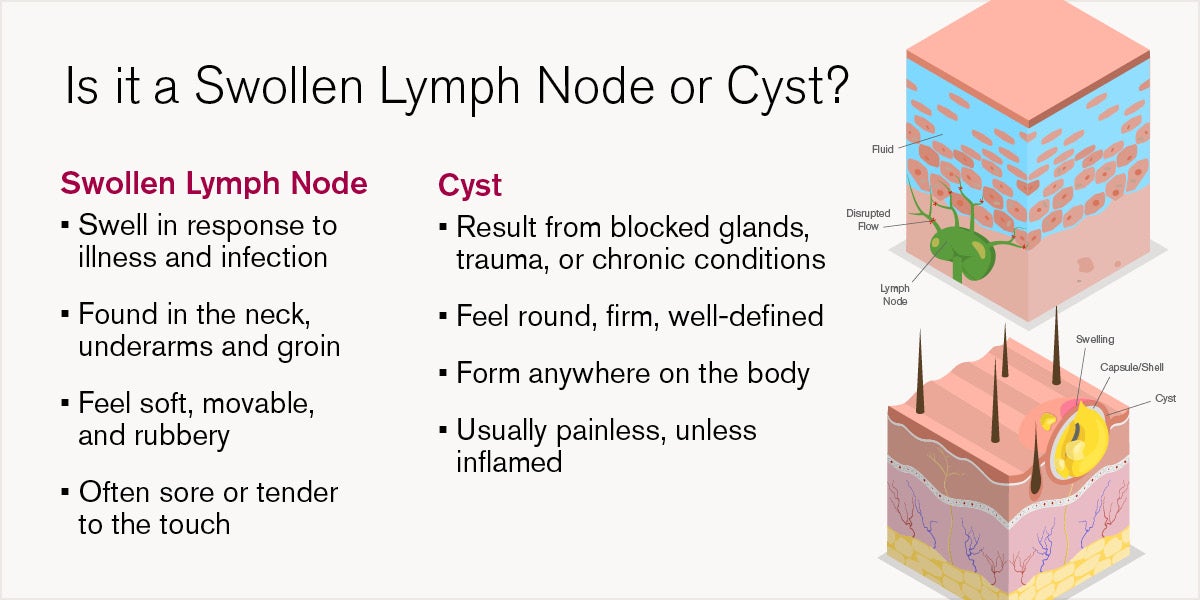Lymph Nodes vs. Cysts: How to Tell the Difference and When to See a Doctor
May 29, 2025
Categories: General Surgery
Tags: Lymph Nodes, Cysts

By: Jacqueline Kalmoe, MD, General Surgery
It’s not unusual to discover a lump beneath your skin, perhaps on your neck, in your armpit, or near your jaw, and immediately feel concerned. These lumps are often either swollen lymph nodes or cysts. While both are common and usually harmless, they can feel similar at first, making it hard to tell them apart without medical input.
Understanding the differences between the two can help you know when to monitor the lump and when to seek professional care.
“It’s completely normal to feel concerned when you discover a lump under your skin. The good news is that most of these are harmless—but understanding what you’re feeling is the first step toward knowing whether to monitor it or seek care," says Jacqueline Kalmoe, MD, general and trauma surgeon at Loyola Medicine.
What are lymph nodes?
Lymph nodes are small, bean-shaped structures that serve as important filters in your immune system. They help trap bacteria, viruses, and other harmful substances, preventing them from spreading throughout the body. Each node contains immune cells that destroy these invaders and support your body’s defenses.
Clusters of lymph nodes are located in specific areas:
- Neck
- Underarms
- Around the collarbone
- Groin
“Lymph nodes are often your body’s early warning system. When they swell, it usually means your immune system is actively fighting something even if you don’t feel sick yet," says Dr. Kalmoe.
It's important to check these areas semi-regularly, especially under your arms to perform general breast awareness. Lymph nodes often become swollen in response to infections. This is a normal reaction and usually indicates that your body is fighting off illness, such as a cold, strep throat, or an ear infection. Swollen lymph nodes are typically soft, mobile under the skin, and tender to the touch. Once the infection clears, they usually return to their normal size.
However, lymph nodes can also swell for other reasons, such as autoimmune diseases, cancers like lymphoma, or conditions like sinus malignancy that causes enlarged neck lymph nodes. When this happens, the swelling may persist, and the nodes may feel hard or immobile.
What are cysts?
Cysts are fluid-filled sacs that form beneath the skin or inside the body. They are not connected to your immune system, and they usually develop due to blocked glands, infection, trauma, or chronic conditions. Most cysts are benign and slow-growing.
Common types of cysts include:
- Epidermoid cysts – Made up of keratin and typically found on the face, neck, or trunk.
- Sebaceous cysts – Often appear on the scalp, face, or back, caused by blocked oil glands.
- Ganglion cysts – Typically develop around joints, especially in the wrist or hand.
Cysts often feel round, firm, and well-defined. They are usually painless unless they become infected or inflamed. Infected cysts may become red, swollen, and tender, and they may drain pus. Most cysts can remain the same size for years, although some can grow or fluctuate.
“Unlike lymph nodes, cysts don’t usually signal an immune response. They form for a wide range of reasons and often go unnoticed unless they grow large or become irritated," says Dr. Kalmoe.

How to tell the difference between a swollen lymph node and a cyst
Although lymph nodes and cysts can both present as lumps under the skin, their characteristics often can help you tell them apart.
Lymph nodes tend to follow predictable patterns and are located in specific regions that align with the body’s immune pathways. You’re more likely to find them in the neck, underarms, and groin, especially if you’re sick. Cysts, on the other hand, can form nearly anywhere on the body and are not confined to particular areas.
In terms of how they feel, lymph nodes are usually softer and have a rubbery texture. They often shift slightly when pressed and may feel tender, particularly if swollen from infection. In contrast, cysts typically feel firmer and more rounded, and they tend to stay fixed in place when touched. Unless inflamed, cysts are not painful.
Timing is another important distinction. Lymph nodes often swell quickly and resolve within a few days or weeks as the immune system recovers. Cysts form more slowly and may remain unchanged for long periods or grow gradually without disappearing on their own.
“We look at location, texture, and timing to distinguish between cysts and lymph nodes. Where the lump appears, how it moves, and whether it’s painful can tell us a lot before we even do imaging," says Dr. Kalmoe.
When to seek medical attention for a lump under the skin
It’s important to know when a lump should be evaluated by a health care provider. You should make an appointment if you notice:
- A lump that grows rapidly or does not go away after a few weeks
- A hard, immobile, or irregularly shaped mass
- Persistent tenderness, redness, or signs of infection like drainage or fever
- Accompanying symptoms such as unexplained weight loss, night sweats, or fatigue
- A personal or family history of cancer
Early evaluation can help determine whether the lump is harmless or needs treatment.
“Any lump that persists, changes, or comes with other symptoms should be evaluated. It may be nothing, but early evaluation can be critical for peace of mind and proper care," says Dr. Kalmoe.
Diagnosing lumps and bumps
When you visit a doctor for a lump, the evaluation typically begins with a thorough medical history. Your provider will ask how long the lump has been present, whether it has changed in size or feel, and if it’s associated with any symptoms like fever or weight loss. They will also perform a physical exam to assess its texture, mobility, and location, factors that can help distinguish between a cyst and a lymph node.
If further evaluation is needed, your doctor may order imaging studies. An ultrasound is often the first step, as it can determine whether the lump is solid or filled with fluid. Depending on the results and clinical suspicion, more advanced imaging like a CT scan or MRI may be used to look more closely at deeper or larger masses.
If the nature of the lump is still unclear, a biopsy or fine-needle aspiration may be recommended. This involves collecting a small sample of tissue or fluid from the lump for laboratory testing, which can confirm the diagnosis and guide appropriate treatment.
Treatment options for swollen lymph nodes and cysts
Treatment depends on what’s causing the lump:
- Swollen lymph nodes often resolve without treatment, especially if they’re due to a minor viral illness. If the swelling is related to a bacterial infection, antibiotics may be prescribed. For persistent or unexplained swelling, further testing may be needed to rule out conditions like autoimmune disorders or lymphoma.
- Cysts that are small, painless, and not changing in size may not require any treatment at all. If a cyst becomes painful, infected, or interferes with daily life, it may be drained or surgically removed. Infected cysts might also be treated with antibiotics. It’s important not to attempt to pop or drain a cyst at home, as this can lead to infection or scarring.
Jacqueline Kalmoe, MD, is a board-certified general and trauma surgeon at Loyola Medicine, specializing in surgical critical care and general surgery. Dr. Kalmoe earned her medical degree from Loyola and completed her residency there, followed by a fellowship in surgical critical care at Stroger Hospital. She is known for her compassionate, patient-centered approach and is actively involved in research and medical education.
